Nesactium
Q923561Nesactium: Histrian hillfort, Roman town, modern Vizače in Croatia.
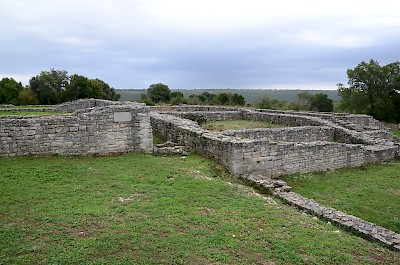
Although the hillfort of Nesactium has been inhabited since the Neolithic, the first monumental architecture dates from the Bronze Age. The plateau, which rises more than 120 meters above a rather inaccessible part of the southeastern coast of Istria (ancient Histria), was surrounded by a rampart, especially in the west, where the slope is not very steep. Archaeologists have recognized terraces as well.
In the Iron Age, the walls were improved and the western gate, which dates back to the fourth or third century, is still visible. Beyond it, on the western slope, was a necropolis with cremation tombs from the ninth to fourth centuries BCE. The urns were placed in “boxes” made of limestone slabs. Pottery finds document trade contacts with Daunia in the “heel” of Italy, Etruria, the Veneto, and Greece. A bronze vessel was decorated with an interesting picture of a boat.
In the late 180s, the Histrians united under a king named Aepulo or Epulon, and attacked the new Roman colony at Aquileia. After several campaigns, the Romans invaded Histria and laid siege to Nesactium in the spring of 177 BCE. According to Livy, the first Roman commanders, Aulus Manlius Vulso and Marcus Junius, failed to take the city, but their successor, consul Gaius Claudius Pulcher, was more successful. He first redirected the river that prevented an attack from the east, allowing the hill to be stormed from a different direction. When the defenders knew that their town was about to be taken, they killed their wives and children. Still, more than 5,000 Histrians were sold as slaves. King Aepulo committed suicide.note
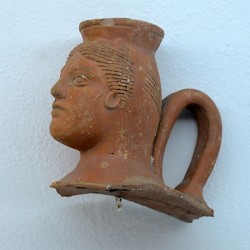
In the Roman age, the new capital of Histria was Pola (modern Pula), twelve kilometers to the west, a hillfort with a perfect harbor. Nesactium, however, remained in use, and under the Roman Empire, it was small provincial town. The old Histrian gods were still venerated – archaeologists have found altars dedicated to Eia, Trita, and “the Histrian sea and land”. Of the Roman gods, Silvanus and the Bona Dea are attested. A curious Latin inscription mentions the Greek goddess Hera, whom we would have expected to be called Juno.note. Cybele and Mithras are known from sculpture.
When the old wall was restored, the western gate became a water conduit, but a new gate was added (the “Porta Polensis”). From here, a visitor would reach the forum, where he would find a portico and a triple temple from the beginning of the common era, which the excavators have called the Capitol. Just north of the forum was a bathhouse, separated in a part for men and women. An inscription from the reign of the emperor Gordian III (r.238-244) mentions the R P Nes (res publica Nesactiensium) and allows us to identify the ruins with the town mentioned by Livy.note
At the end of the fourth century, the walls were renewed. Two churches were added, next to each other, between the bathhouse and the forum. The southern one, the largest, was probably dedicated to Mary and used for the daily ceremonies; the northern one was used for baptisms and religious ceremonies. There are traces of fire, which may have something to do with the Avar attacks on Histria in 600 and 611.
The city was abandoned but its name lives on its modern names: Nezakcij and Vizače. Most finds are in the museum in Pula.
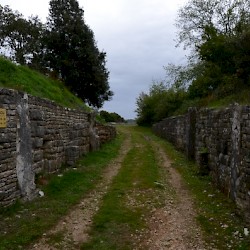 Nesactium, Porta Polensis |
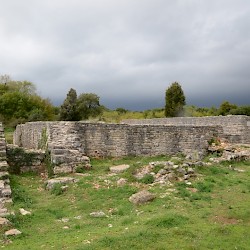 Nesactium, Capitol |
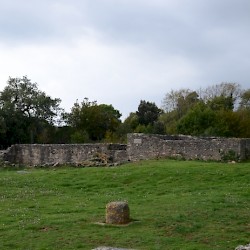 Nesactium, Capitol |
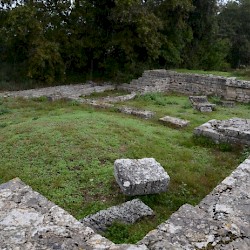 Nesactium, Baths |
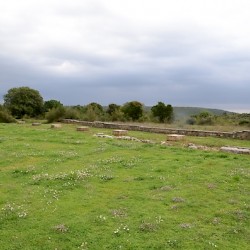 Nesactium, Forum, Porticus |
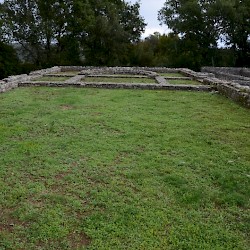 Nesactium, North Basilica |
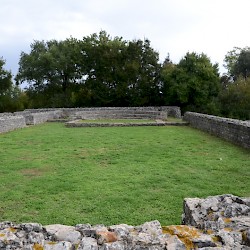 Nesactium, South Basilica |
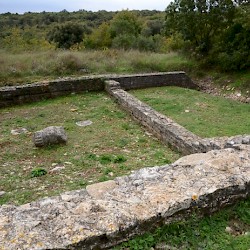 Nesactium, House |